

| Crickets and Grasshoppers in Nottinghamshire | |
| The current status of Nottinghamshire Orthoptera | |
| Grasshoppers are among some of the
best known insects, but as many species are difficult to
observe closely, they are often not seen well enough to
identify. To make matters more difficult, there are
considerable variations within some species, which is
another factor hindering those wishing to identify them.
A net is therefore recommended for capture and study. They belong to the order Orthoptera, of which there are four main families including Grasshoppers, Groundhoppers, Bush Crickets and True Crickets. The current UK list contains around 30 species, including some known migrants/accidentals. Recent years have seen an exciting period for Orthoptera and our increasingly warmer climate has allowed several species expand their UK ranges. Some recent Nottinghamshire colonistsThree of the species expanding their UK ranges, promptly arrived in Nottinghamshire after the turn of the century and increasing Nottinghamshire's present Orthoptera fauna list to 15 species. |
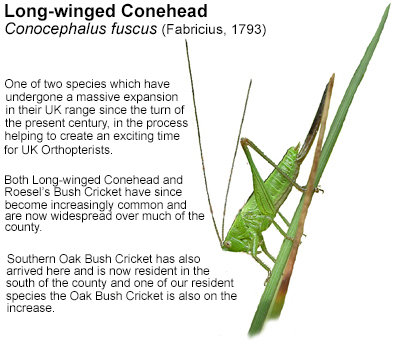 |
|
| ..... | ||
|
Lesser Marsh Grasshopper (Chorthippus albomarginatus) was the first of the three to appear in Nottinghamshire in 2000. Roesel's Bush Cricket (Roeseliana roeselii) arrived in 2006 and beat the first Long-winged Conehead (Conocephalus fuscus) by a matter of weeks. Since arriving, all three species have spread to reach most parts of Nottinghamshire by the end of 2011. But these have not been the only new Crickets or Grasshoppers to appear in recent years. The Southern Oak Bush Cricket (Meconema meridionale) was recorded for the first time (twice) from a Bilborough garden in 2009, but not again until 2017, when found at two sites by Tim Sexton. Our most recent addition however, remains the Short-winged Conehead (Conocephalus dorsalis) in 2011 and originally discovered at Attenborough Nature Reserve by Richard Rogers, before a quick follow-up record from Gunthorpe by Roy Frost. The Short-winged Conehead's range-expansion looks likely to continue over the next few years. |
||
| ..... | ||
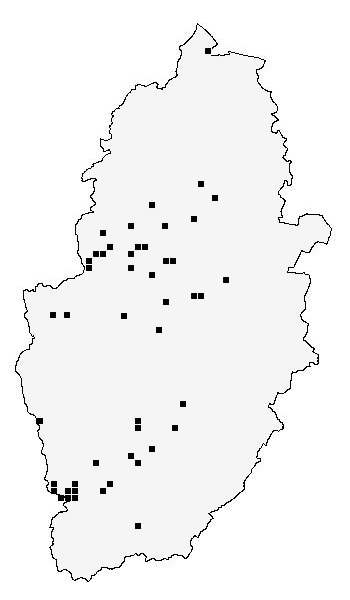 |
Rare and scarce
Nottinghamshire Orthoptera Despite much success for our most Nottinghamshire Orthoptera, two species still remain genuine county rarities and one may have disappeared altogether. Perhaps the most restricted species in the county is the Stripe-winged Grasshopper (Stenobothrus lineatus) which is still only to be found at Budby South Forest. It's occurrence here is especially interesting, as this is a relatively isolated site and in one of just three 10Km grid squares, north of a line between the Wash and the Severn estuary as far as we know. The Speckled Bush Cricket (Leptophyes punctatissima) is now known from at least ten sites in Nottinghamshire and is still increasing it's range here. However, the non-native House Cricket (Acheta domesticus) is very rarely reported now. The Dark Bush Cricket (Pholidoptera griseoaptera) was another species believed to have declined in Nottinghamshire, and at one time was feared extinct in the county. Over ten years ago, the last known Nottinghamshire record was from the Bingham Linear Park in 2003, where it were recorded by Paul Waring. Roy Frost (Nottinghamshire's Orthoptera recorder) conducted an unproductive search in August 2011 and although the site still contained suitable habitat, it was feared that it had been lost from that site. However, in September 2013, we received confirmation that it had been discovered at Weston in the Trent Valley and had been present there since at least 2011 and where it still does well to this day. It has recently (August 2022) been found at Kirton Wood. Our thanks go to Roy Frost (the Orthoptera recorder for Nottinghamshire) for providing the information regarding the status of some of the rarer Crickets and Grasshoppers in Nottinghamshire. Roy has also written and compiled a complete, up to date list of species, with a review of the records and distribution of Nottinghamshire Orthoptera, accessible via the link at the top and bottom of this page. Left:- The Nottinghamshire distribution of Long-winged Conehead Conocephalus fuscus, as of December 2018. |
|
| Long-winged
Conehead Conocephalus fuscus (Fabricius,
1793) |
||
| A recent colonist, Nottinghamshire's first record of this rapidly spreading species came in 2007 when it was discovered at Keyworth Meadow in the far south of the county. It subsequently spread rapidly, being found at Attenborough Nature Reserve and north-east up the Trent Valley within the space of a few years. In August 2011, it was discovered at Shirebrook Pit Wood and Lound Gravel Pits near Retford, so the Long-winged Conehead is obviously widespread in Nottinghamshire now. Both sexes are fully-winged and the wings reach beyond the end of the abdomen in adults. | ||
| .......... | ||
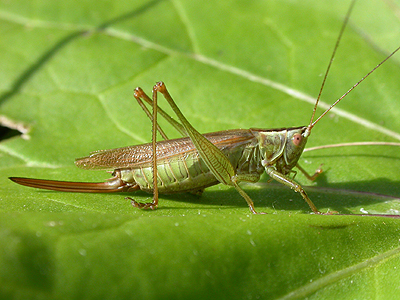 |
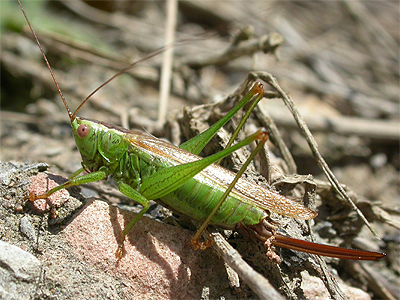 |
|
| Short-winged
Conehead
Conocephalus dorsalis (Latreille,
1804) |
||
| Although there are numerous records from those counties surrounding Nottinghamshire, Short-winged Conehead remains known from only a handful of sites across Nottinghamshire. It was first recorded from Attenborough NR and the East Bridgford side of the River Trent at Gunthorpe in 2011, then from Bevercotes Pit Wood and Cottam in 2014 and Kilvington West Lake in 2015. The county recorder has recently supplied some additional Short-winged Conehead records from Stapleford (moorbridge Lane Welands North LWS) in 2019 and again in 2022. In 2023 it was found in good numbers at Penny Pasture Common, Eakring Meadows. | ||
| .......... | ||
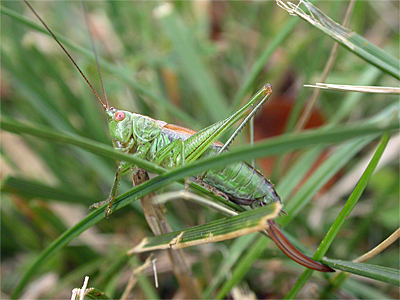 |
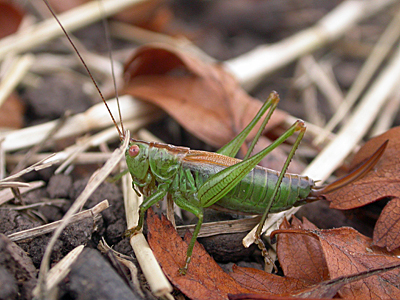 |
|
| Oak
Bush Cricket Meconema thalassinum
(De Geer, 1773) |
||
| The Oak Bush Cricket is probably fairly commonly distributed across much of Nottinghamshire and it is often attracted to lights left on overnight. One such record came from Eakring village Post Office, but this quite large green Bush Cricket is relatively easy to find by searching the trunks of trees or beating foliage in wooded areas during the Summer and Autumn months. Adults and nymphs are regularly recorded from Budby South Forest and at other Sherwood Forest sites. | ||
| .......... | ||
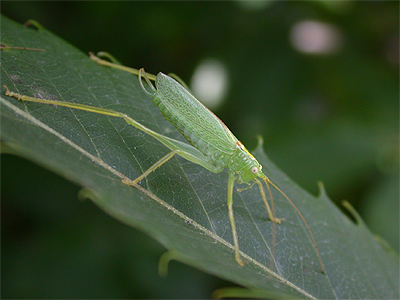 |
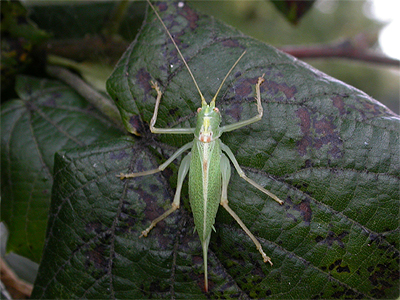 |
|
| Southern
Oak Bush Cricket
Meconema
meridionale (Costa, 1860) |
||
| Not recorded in the UK until 2001, but now established in many south-eastern counties. Southern Oak Bush Cricket is currently still rare in Nottinghamshire with only a handful of records, all of which have so far come from the south-west of the county. One in a Bilborough on 09/09/07, was Nottinghamshire's first ever and the most northerly UK record at the time. We are aware of no other records until found by Tim Sexton at Nottingham University (Highfields) on 02/10/17 and at Attenborough NR on 10/10/17. Our thanks go to Tim Sexton for providing us with the photographs below. | ||
| .......... | ||
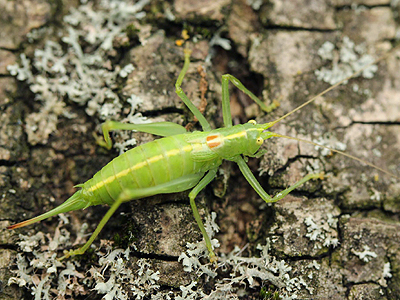 |
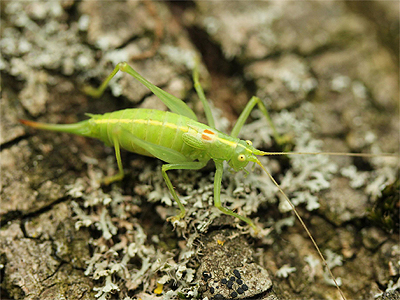 |
|
| Speckled
Bush Cricket Leptophyes
punctatissima
(Bosc, 1792) |
||
| The Specked Bush Cricket is still quite a rarity in Nottinghamshire, being recorded from just a handful of sites. Like many Orthoptera, this is probably due to under-recording, rather than being actually locally scarce. Our first records actually came from a suburban garden on Sandford Road in Mapperley Nottingham, before finding a previously unkown colony, situated along a forest track leading to Budby South Forest in 2009. The adults can be looked for during August, but are often extremely difficult to see amongst low foliage, even though good numbers may be present at a site. Both sexes have short wings. | ||
| .......... | ||
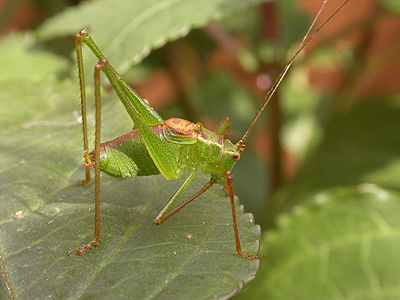 |
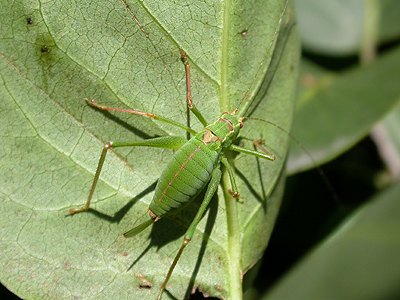 |
|
| Dark
Bush Cricket Pholidoptera
griseoaptera (De Geer, 1773) |
||
| This large species was thought to have died out here, with no Nottinghamshire records since last recorded along the Bingham Linear Park in 2003. But it was reported by Louise and Alastair Gordon from field edges/ditches at Weston in the Trent Valley, where it had apparently been present since at least 2011 and remains in that area, being recorded in good numbers (audibly) in August 2022. It has since been found at Kirton Wood by Nick and Samantha Brownley, so is obviously more widespread in Nottinghamshire than thought, probably at a number of sites along the Trent Valley. | ||
| .......... | ||
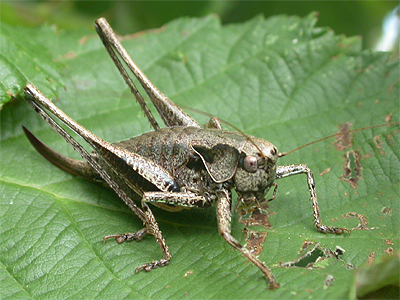 |
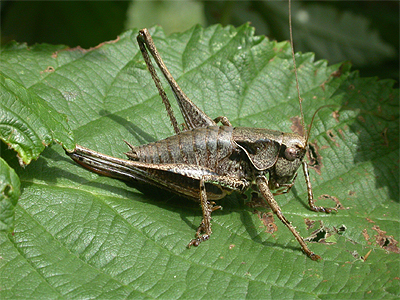 |
|
| Roesel's
Bush Cricket
Roeseliana
roeselii (Hagenbach,
1822) |
||
| Roesel's Bush Cricket first arrived in Nottinghamshire in 2006 when it was found by the A453 near Clifton. By the following year, it was found at Collingham, Stoke Bardolph and Langford Lowfields and has continued it's north-westerly spread since, reaching the Nottinghamshire/Derbyshire border at Shirebrook Pit Wood by 2011. The high-pitched sound made by the male is difficult to hear, but we have found them even more difficult to actually see. The Roesel's Bush Cricket is usually brown, although a green form does occur. A broad cream margin runs around the sides of the pronotum, and there is a series of three pale yellow spots on the sides of the thorax. Short-winged and flightless, but a fully-winged form does occur in hot Summers. | ||
| .......... | ||
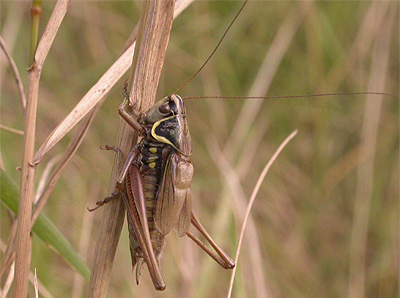 |
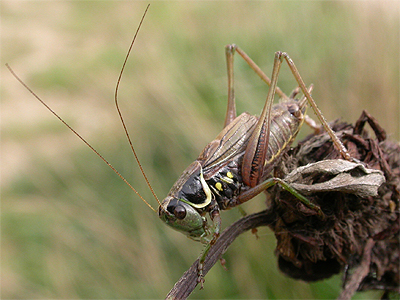 |
|
| Field
Grasshopper Chorthippus brunneus (Thunberg,
1815) |
||
| The commonest and most widespread Grasshopper, the Field Grasshopper is the most likely species to wander well into urban gardens. Overall, this Grasshopper is a mixture of shades of brown and the sharply incurved pronotal side-keels a key identification feature. Both male and female are fully winged. | ||
| .......... | ||
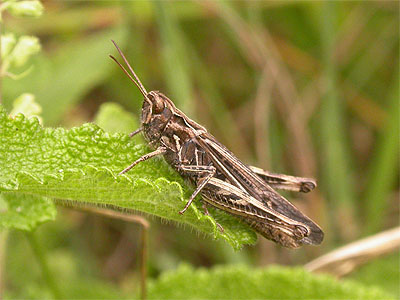 |
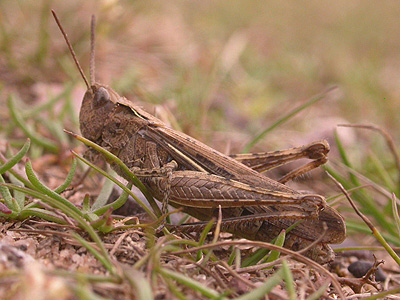 |
|
| Lesser Marsh Grasshopper Chorthippus
albomarginatus (De
Geer, 1773) |
||
| The Lesser Marsh Grasshopper first appeared in Nottinghamshire in 2000 and is now a widespread and common species at many grassy sites in the county. Very similar in appearance to the Meadow Grasshopper, the Lesser Marsh Grasshopper is a more dull coloured species, usually being straw or light green-coloured and distinctly less bright green than Meadow Grasshopper. The almost parallel side keels of the pronotum, are a good pointer towards identification and this Grasshopper is fully-winged, though rarely reaching the end of the abdomen. | ||
| .......... | ||
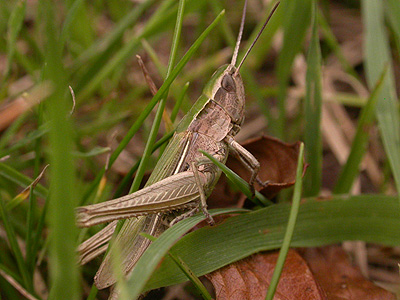 |
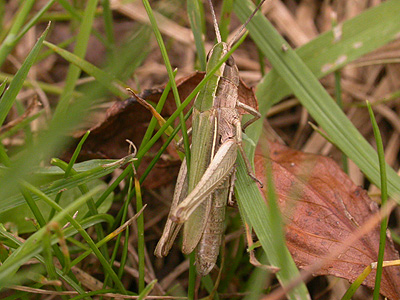 |
|
| Meadow
Grasshopper Chorthippus parallelus (Zetterstedt,
1821) |
||
| A very common Grasshopper of grassy areas. Adults are green-coloured but often with brown wings and some adults can be entirely brown. The side-keels of the pronotum are only very slightly incurved. Some adult females and nymphs can be vivid pink/purple. Male Meadow Grasshoppers are fully-winged, but the females are usually short-winged, though fully-winged females can occur. | ||
| .......... | ||
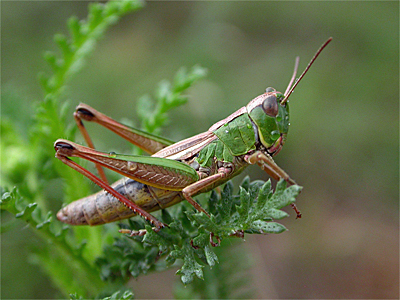 |
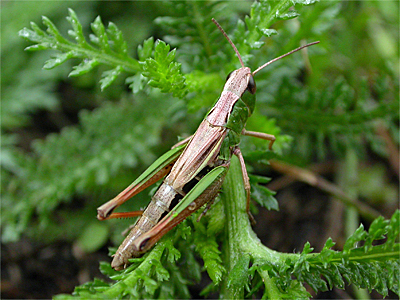 |
|
| Common
Green Grasshopper
Omocestus
viridulus (Linnaeus, 1758) |
||
| A common species in grassy areas. This is another of the largely green or green and brown Grasshoppers, but there is never any red or orange colouration on the abdomen, a feature which helps towards identification. Adult females are green along the top of the head and pronutum, though can be green, brown or even bright purple elsewhere. The side-keels of the pronotum are gently incurved. Both sexes are fully-winged. | ||
| ...... | ||
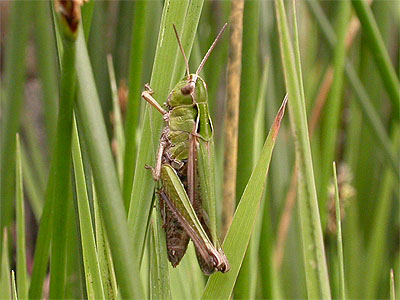 |
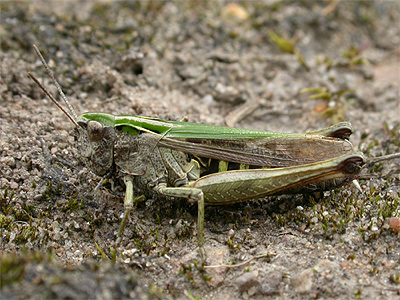 |
|
| Mottled
Grasshopper Myrmeleotettix
maculatus (Thunberg, 1815) |
||
| The Mottled Grasshopper is restricted in Nottinghamshire to some heathland sites, though we have personally only found it at Budby South Forest and more recently at Sherwood Heath SSSI. Even at Budby, it can be quite a difficult Grasshopper to find, seeming to prefer sparsely vegetated ground with heather re-growth. Identification of Mottled Grasshopper is relatively easy (despite there being many named colour forms), simply by checking for the clubbed antennae which is characteristic of this species. | ||
| ...... | ||
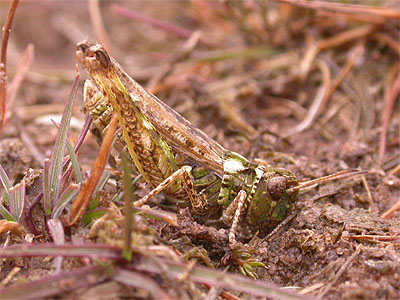 |
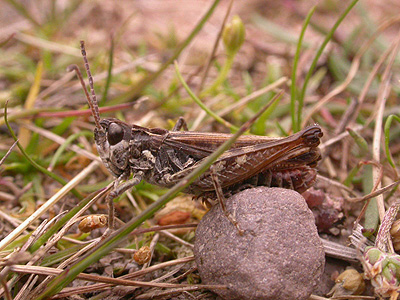 |
|
| Stripe-winged
Grasshopper Stenobothrus lineatus (Panzer,
1796) |
||
| This is a rare and restricted Grasshopper in Nottinghamshire and the Midlands. As far as we know, in Nottinghamshire, it is still only found at Budby South Forest. The Stripe-winged Grasshopper being in Nottinghamshire is quite an interesting fact in itself, as it is extremely isolated from most other UK sites where this Grasshopper is found. All other sites except two in Yorkshire, lie south of a line between the Wash and the Severn estuary. Stripe-winged Grasshopper is a brightly coloured species, usually green and brown with some degree of orange/red on the abdomen. The pronotal keels are gently incurved and there is a white line and stigma on the forewing. Both sexes are winged. | ||
| ...... | ||
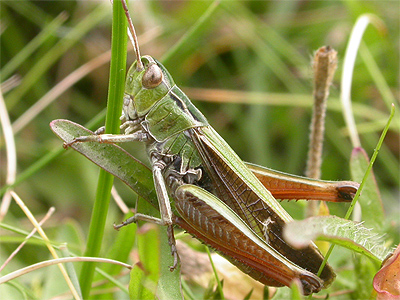 |
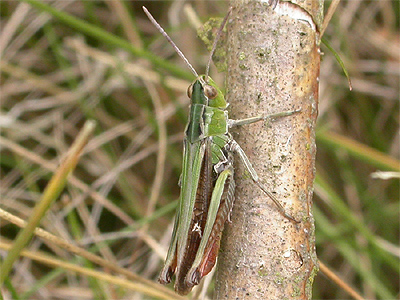 |
|
| Slender
Groundhopper Tetrix subulata (Linnaeus,
1758) |
||
| This is a common Groundhopper found at many sites. Seperation from Common Groundhopper is easy, with Slender Groundhopper having a much longer pronutum and wings of near equal length. The dry stony slopes of Warsop Main Pit Top has a large population and it seems fairly common around the Sherwood Forest area. There is considerable variation in both intensity of markings and colouration within this Groundhopper. | ||
| ..... | ||
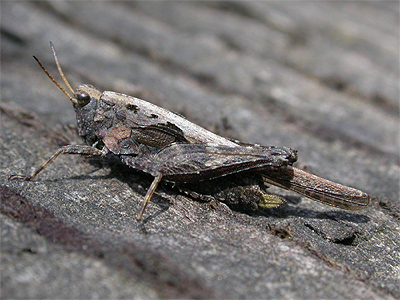 |
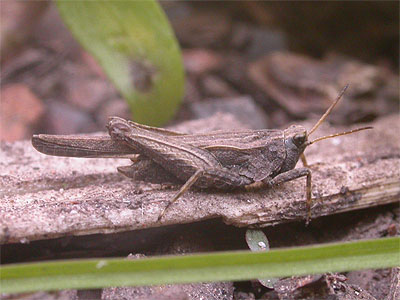 |
|
| Common
Groundhopper Tetrix undulata (Sowerby,
1806) |
||
| This is a widespread species, yet can be elusive and easily missed when found with large numbers of Grasshopper nymphs. Seperation from Slender Groundhopper is easy, as the wings in this species are shorter than the pronutum, which itself is no longer than the abdomen. Usually can be found on most of Nottinghamshire's former pit tops, often in slightly damper locations than the Slender Groundhopper. | ||
| ..... | ||
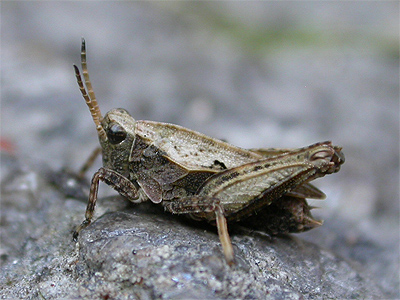 |
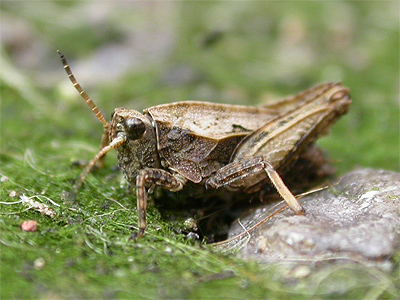 |
|
|
House Cricket
Acheta domesticus (Linnaeus, 1758) |
||
| Formerly widespread in heated premises such as hospitals and bakeries, even found underground in coal mines. The non-native House Cricket now occurs only very occasionally, with the most recent records coming from Beeston in 2003, Upper Saxondale c2006 and Ruddington in 2011. We have had odd records from the vicinity of our house at Market Warsop over the past 30 years, including this one which appeared in late March 2019. Most recent county records are likely escapees, as this species is very commonly used as live food for some exotic pets. | ||
| .. | ||
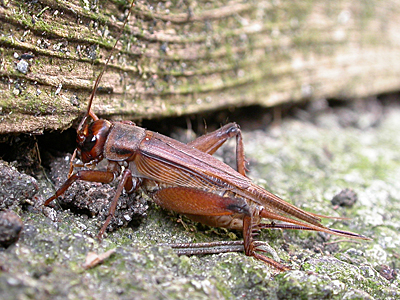 |
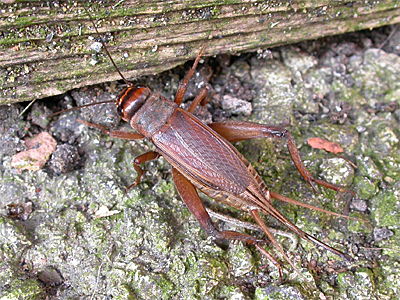 |
|
|
Jamaican Field Cricket
Gryllus assimilis (Fabricius, 1775) |
||
| Commonly supplied by the pet trade as live food for spiders and reptiles, the Jamaican Field Cricket is very similar to the House Cricket. It is most easily differentiated from the House Cricket, by the four dark bands running vertically on top of the head. This species does not occur naturally in the UK, but is likely to be encountered with the popularity of keeping exotic pets. | ||
| .. | ||
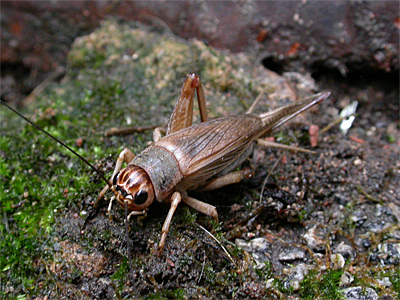 |
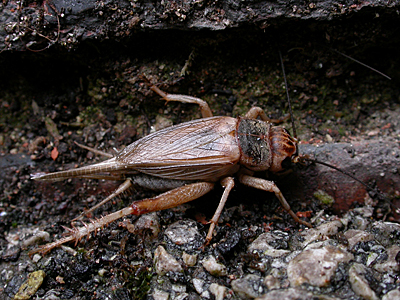 |
|
| The current status of Nottinghamshire Orthoptera |
| Insect identification |
| Homepage |